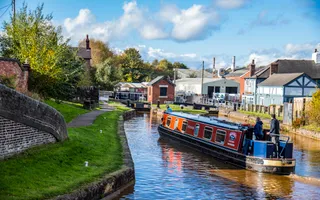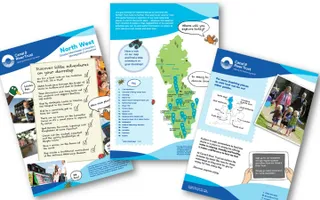This cross-country canal takes in the best of what the North Midlands has to offer, with stunning views over the Cheshire Plain.
History of the Trent & Mersey Canal
Engineered by James Brindley, the Trent & Mersey was the country's first long-distance canal. It is full of interesting features, which reflect its history. These include Harecastle Tunnel, the lengthy lock flight known as ‘Heartbreak Hill', and the traditional canal town of Shardlow.
Some of the leading aristocrats, gentry and industrialists of the area engaged James Brindley, then a little-known mill engineer, to survey a canal from the Mersey to the Trent. A later version of this scheme, then known as the Grand Trunk Canal, was approved by Parliament in 1766, on the same day as the canal joining it to the Severn. Brindley was the engineer of both canals.
Josiah Wedgwood was one of the main promoters of the Trent & Mersey Canal, and its branch the Caldon Canal. The waterways allowed fragile porcelain and china to be transported without breaking on bumpy roads. Once the products had been delivered, the narrowboats could be filled with West Country china clay for their return trip. Potteries are still to be found along the Trent & Mersey and Caldon Canal in Stoke.
Harecastle Tunnel
The part south of Harecastle Tunnel was completed first. Harecastle Tunnel took 11 years to build, and by the time it was complete, and open Brindley had been dead for five years.
Major offshoots include the Wardle Branch, now usually regarded as part of the Shropshire Union's Middlewich Branch, the Hall Green Branch, similarly now generally considered to be part of the Macclesfield Canal, and the Caldon, which has since earned the title of a canal in its own right.
It also connects via the restored Anderton Boat Lift to the Weaver Navigation, and with the Staffordshire & Worcestershire and the Coventry Canals.
The derelict Derby & Sandiacre Canal that connected at Swarkestone is under restoration, but the former Bond End Canal at Shobnall, Burton-on-Trent, is largely lost.
The canal is broad between Shardlow and Burton-on-Trent because this part was used by barges coming off the Trent. The rest of the canal was narrow, but the section from Anderton to Middlewich was widened in the 1890s to accommodate broad boats from the Weaver. (Hence the ‘Big Lock' at Middlewich.)
The Potteries
The canal led directly to the development of the area subsequently known as the Potteries. It was also a major factor in the development of Burton-on-Trent as the country's brewing capital.
Traffic was heavy and freight movement was still considerable into the 1950s, with cargoes including coal, salt, beer and, of course, pottery. Nowadays the canal is an essential element in both the Cheshire and the Four Counties cruising rings.
The Cheshire Locks
The long flight of locks which drops the canal down from Stoke-on-Trent to the Cheshire Plain, have been mischievously renamed 'Heartbreak Hill' by generations of leisure boaters. This is because the locks are close enough for the lock crew to stay on the towpath, rather than getting back on board, but far enough apart to make serious inroads on your shoe leather. Think of it as a character-building experience.






